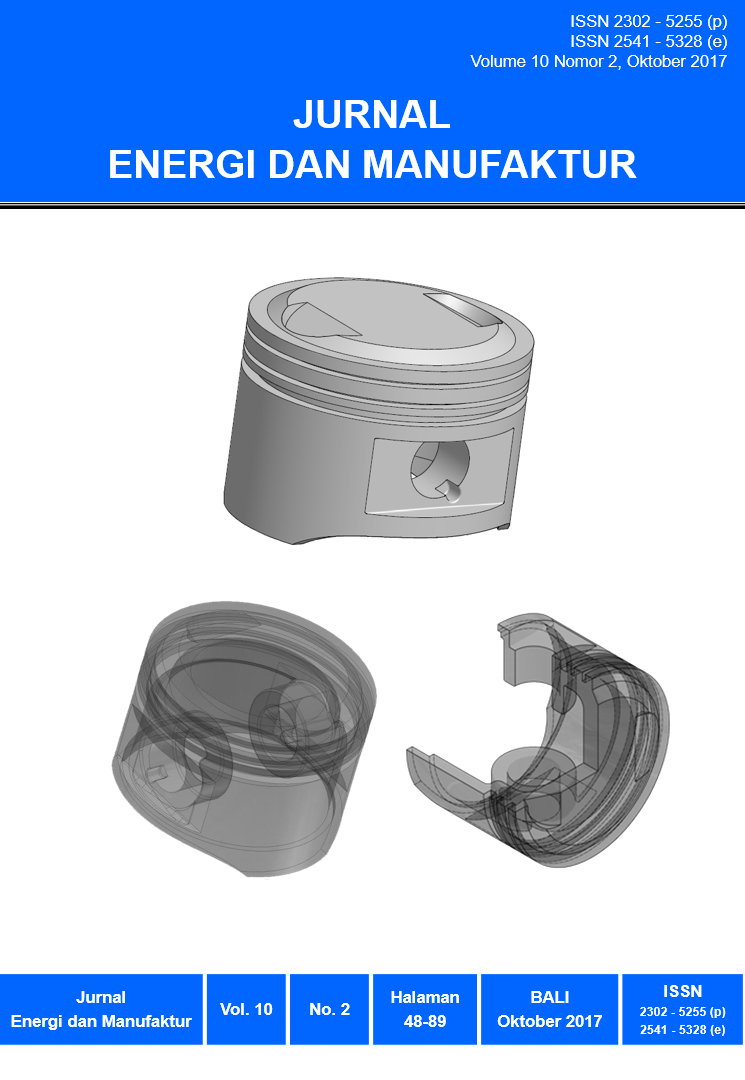Kajian eksperimental head losses katup limbah pompa hydram
Abstract
Abstrak
Disain katup limbah yang baik dan penyetelan panjang langkah (stroke) yang tepat merupakan faktor penting untuk operasi pompa hydram yang halus dan efisien. Katup limbah harus mampu menutup dengan cepat untuk menghasilkan tekanan tinggi pada saat terjadi water hammer. Disain detail katup limbah meliputi luas lubang katup limbah, luas penampang piringan katup, dan panjang langkah katup. Penelitian sebelumnya menyarankan bahwa diameter lubang katup limbah harus sama atau lebih besar dengan diameter pipa penggerak untuk menghindari terhambatnya aliran air keluar katup limbah. Namun diameter optimal katup limbah belum diketahui. Katup limbah tertutup akibat gaya drag yang terjadi karena aliran air melewati katup tersebut. Jadi geometri katup limbah adalah sedemikian rupa sehingga gaya seret tersebut meningkat dengan cepat sesuai arah pergerakan katup tersebut menuju posisi tertutupnya. Friction drag mengakibatkan kehilangan energi atau head losses aliran air melewati katup limbah yang merupakan besarnya perubahan energi aliran sebelum dan sesudah katup limbah tersebut. Head losses tersebut dapat diinvestigasi dengan mengukur tekanan di bawah katup limbah dan debit aliran yang mengalir melewati katup limbah tersebut pada posisi kesetimbangannya. Hasil penelitian menunjukkan bahwa rasio diameter lubang katup limbah terhadap diameter pipa penggerak yang mengakibatkan head losses terendah adalah sekitar 130 persen atau pada rasio luas penampangnya sekitar 172 persen. Kata kunci: Pompa hydram, katup limbah, head losses, rasio diameter
Abstract
Suitable design and appropriate stroke adjustment of a waste valve are important factors for smooth and efficient hydram pump operation. The waste valve must be able to close quickly to produce high pressure during a water hammer take placed. In addition, detailed design of the waste valve comprises of the hole-diameter of the valve, the cross-sectional area of valve disc, and the valve step stroke. Prior researches suggest that the hole-diameter of the waste valve should be equal to or greater than the diameter of the drive pipe to avoid obstruction of the outflow passes throught the waste valve. However, the optimal diameter of the waste valve is unidentified yet. The waste valve is closed due to the drag force that take places as the water flow passes through the valve. Therefore, the geometry of the waste valve is such that the drag force increases rapidly as the direction of the valve moves to its closed position. Friction drag results in loss of energy or head losses of water flow through the waste valve which is the magnitude of the change of energy flow before and after the waste valve. Head losses can be investigated by measuring the pressure under the waste valve and the flow discharge flowing through the waste valve at its equilibrium position. The results showed that the ratio of the diameter of the waste valve to the diameter of the diameter of the drive pipe which is resulting in the lowest head losses was about 130 percent or at the cross-sectional area ratio was about 172 percent. Keywords: Hydraulic ram, waste valve, head lsses, diameter ratio
Downloads









